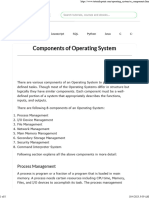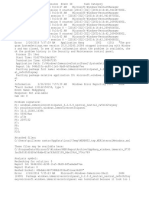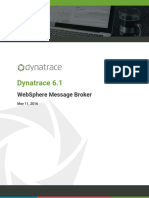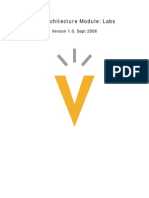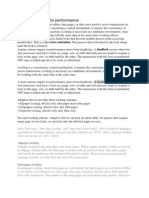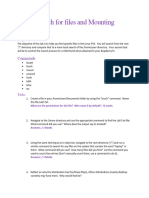4/3/24, 7:53 PM Components of Operating System
Components of Operating System
Learn Cybersecurity Open
Essentials
There are various components of an Operating System to perform well defined tasks.
Though most of the Operating Systems differ in structure but logically they have
similar components. Each component must be a well-defined portion of a system
that appropriately describes the functions, inputs, and outputs.
There are following 8-components of an Operating System:
Process Management
I/O Device Management
File Management
Network Management
Main Memory Management
Secondary Storage Management
Security Management
Command Interpreter System
Following section explains all the above components in more detail:
Process Management
A process is program or a fraction of a program that is loaded in main memory. A
process needs certain resources including CPU time, Memory, Files, and I/O devices
to accomplish its task. The process management component manages the multiple
processes running simultaneously on the Operating System.
A program in running state is called a process.
The operating system is responsible for the following activities in connection with
process management:
Create, load, execute, suspend, resume, and terminate processes.
Switch system among multiple processes in main memory.
https://www.tutorialspoint.com/operating_system/os_components.htm 1/6
�4/3/24, 7:53 PM Components of Operating System
Provides communication mechanisms so that processes can communicate with
each others
Provides synchronization mechanisms to control concurrent access to shared
data to keep shared data consistent.
Allocate/de-allocate resources properly to prevent or avoid deadlock situation.
I/O Device Management
One of the purposes of an operating system is to hide the peculiarities of specific
hardware devices from the user. I/O Device Management provides an abstract level
of H/W devices and keep the details from applications to ensure proper use of
devices, to prevent errors, and to provide users with convenient and efficient
programming environment.
Following are the tasks of I/O Device Management component:
Hide the details of H/W devices
Manage main memory for the devices using cache, buffer, and spooling
Maintain and provide custom drivers for each device.
File Management
File management is one of the most visible services of an operating system.
Computers can store information in several different physical forms; magnetic tape,
disk, and drum are the most common forms.
A file is defined as a set of correlated information and it is defined by the creator of
the file. Mostly files represent data, source and object forms, and programs. Data
files can be of any type like alphabetic, numeric, and alphanumeric.
A files is a sequence of bits, bytes, lines or records whose meaning is
defined by its creator and user.
The operating system implements the abstract concept of the file by managing mass
storage device, such as types and disks. Also files are normally organized into
directories to ease their use. These directories may contain files and other directories
and so on.
The operating system is responsible for the following activities in connection with file
management:
https://www.tutorialspoint.com/operating_system/os_components.htm 2/6
�4/3/24, 7:53 PM Components of Operating System
File creation and deletion
Directory creation and deletion
The support of primitives for manipulating files and directories
Mapping files onto secondary storage
File backup on stable (nonvolatile) storage media
Network Management
The definition of network management is often broad, as network management
involves several different components. Network management is the process of
managing and administering a computer network. A computer network is a collection
of various types of computers connected with each other.
Network management comprises fault analysis, maintaining the quality of service,
provisioning of networks, and performance management.
Network management is the process of keeping your network healthy for
an efficient communication between different computers.
Following are the features of network management:
Network administration
Network maintenance
Network operation
Network provisioning
Network security
Main Memory Management
Memory is a large array of words or bytes, each with its own address. It is a
repository of quickly accessible data shared by the CPU and I/O devices.
Main memory is a volatile storage device which means it loses its contents in the
case of system failure or as soon as system power goes down.
The main motivation behind Memory Management is to maximize memory
utilization on the computer system.
https://www.tutorialspoint.com/operating_system/os_components.htm 3/6
�4/3/24, 7:53 PM Components of Operating System
The operating system is responsible for the following activities in connections with
memory management:
Keep track of which parts of memory are currently being used and by whom.
Decide which processes to load when memory space becomes available.
Allocate and deallocate memory space as needed.
Secondary Storage Management
The main purpose of a computer system is to execute programs. These programs,
together with the data they access, must be in main memory during execution. Since
the main memory is too small to permanently accommodate all data and program,
the computer system must provide secondary storage to backup main memory.
Most modern computer systems use disks as the principle on-line storage medium,
for both programs and data. Most programs, like compilers, assemblers, sort
routines, editors, formatters, and so on, are stored on the disk until loaded into
memory, and then use the disk as both the source and destination of their
processing.
The operating system is responsible for the following activities in connection with
disk management:
Free space management
Storage allocation
Disk scheduling
Security Management
The operating system is primarily responsible for all task and activities happen in the
computer system. The various processes in an operating system must be protected
from each other’s activities. For that purpose, various mechanisms which can be
used to ensure that the files, memory segment, cpu and other resources can be
operated on only by those processes that have gained proper authorization from the
operating system.
Security Management refers to a mechanism for controlling the access of
programs, processes, or users to the resources defined by a computer
controls to be imposed, together with some means of enforcement.
https://www.tutorialspoint.com/operating_system/os_components.htm 4/6
�4/3/24, 7:53 PM Components of Operating System
For example, memory addressing hardware ensure that a process can only execute
within its own address space. The timer ensure that no process can gain control of
the CPU without relinquishing it. Finally, no process is allowed to do it’s own I/O, to
protect the integrity of the various peripheral devices.
Command Interpreter System
One of the most important component of an operating system is its command
interpreter. The command interpreter is the primary interface between the user and
the rest of the system.
Command Interpreter System executes a user command by calling one or more
number of underlying system programs or system calls.
Command Interpreter System allows human users to interact with the
Operating System and provides convenient programming environment to
the users.
Many commands are given to the operating system by control statements. A
program which reads and interprets control statements is automatically executed.
This program is called the shell and few examples are Windows DOS command
window, Bash of Unix/Linux or C-Shell of Unix/Linux.
Other Important Activities
An Operating System is a complex Software System. Apart from the above
mentioned components and responsibilities, there are many other activities
performed by the Operating System. Few of them are listed below:
https://www.tutorialspoint.com/operating_system/os_components.htm 5/6
�4/3/24, 7:53 PM Components of Operating System
Security − By means of password and similar other techniques, it prevents
unauthorized access to programs and data.
Control over system performance − Recording delays between request for a
service and response from the system.
Job accounting − Keeping track of time and resources used by various jobs
and users.
Error detecting aids − Production of dumps, traces, error messages, and
other debugging and error detecting aids.
Coordination between other softwares and users − Coordination and
assignment of compilers, interpreters, assemblers and other software to the
various users of the computer systems.
https://www.tutorialspoint.com/operating_system/os_components.htm 6/6
































